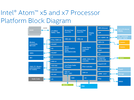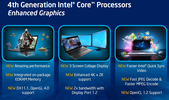Intel HD Graphics (Cherry Trail) vs Intel HD Graphics 5300 vs Intel HD Graphics 4400
Intel HD Graphics (Cherry Trail) ► remove from comparison
The Intel HD Graphics (Cherry Trail) is an integrated graphics card in the Cherry-Trail SoCs (e.g. Atom x7-Z8700). Based on a Broadwell GPU (Intel Gen8) and supports DirectX 11.2. Depending on the SoC offers 12 or 16 EUs.
Atom x7-Z8700: 16 EUs @ 200 - 600 MHz, dual-channel memory
In Windows, gaming is limited to less demanding or quite old games. Using Android, even high end 3D games should run fluently. For example Team Fortress 2 was running on the Surface 3 (x7-Z8700) only in lowest settings and 1280x720 fluently (11 - 69 fps range).
The integrated video decoder is able to display even 4K videos (H.264 tested) fluently.
The Intel HD Graphics GPU in our review sample of the MS Surface 3 (Atom x7-Z8700) only supported DisplayPort 1.1 as it seems, as 4K (3840x2160) with 30 Hz was the maximum Refresh Rate we could achieve (no 60 Hz selectable with the pre-installed drivers).
Intel HD Graphics 5300 ► remove from comparison
The Intel HD Graphics 5300 (GT2) is an integrated Broadwell graphics card revealed in late 2014. It can be found in Core M ULV SoCs such as the Core M-5Y70 . While the GPU shines with its extremely low power consumption, raw performance is quite low and barely sufficient for modern games.
Architecture and Features
Broadwell features a GPU based on the Intel Gen8 architecture, which has been optimized in various aspects compared to the previous Gen7.5 (Haswell). Inter alia, the shader arrays called "subslice" have been reorganized and now offer 8 Execution Units (EUs) each. Three subslices form a "slice" for a total of 24 EUs. Combined with other improvements such as larger L1 caches and an optimized frontend, the integrated GPU has become faster and more efficient than its predecessor.
The HD Graphics 5300 represents the mid-range version of the Broadwell GPU family and consists of one slice with 24 EUs. Beyond that, there is also a low-end variant (GT1, 12 EUs) as well as higher-end models (GT3/GT3e + eDRAM, 48 EUs).
All Broadwell GPUs support OpenCL 2.0 and DirectX 11.2. The video engine can now decode H.265 using both fixed function hardware as well as available GPU shaders. Up to three displays can be connected via DP 1.2/eDP 1.3 (max. 3840 x 2160 @ 60 Hz) or HDMI 1.4a (max. 3840 x 2160 @ 24 Hz). HDMI 2.0, however, is not supported.
Performance
Depending on the specific CPU, the maximum GPU frequency varies between 800 and 900 MHz. Due to the very low TDP, however, the average clock in 3D applications will be significantly lower. Therefore, the HD 5300 just barely outperforms the old HD 4000 or HD 4200 , but requires much less energy for the same performance.
Only a few games as of 2014/2015 will run fluently at low settings, e.g. Dota 2 or Sims 4.
Power Consumption
Thanks to a new 14 nm process, the entire Core M chip is specified at just 4.5 W TDP and is suited for passively cooled tablets. The TDP is flexible and can be reduced or increased, which has a significant impact on performance.
Intel HD Graphics 4400 ► remove from comparison
The Intel HD Graphics 4400 (GT2) is a processor graphics card included in some of the ULV Haswell processors of 2013. The relatively low base clock can be automatically overclocked using Turbo Boost technology. Depending on the processor model, the turbo clock rates may differ, resulting in varying graphics performance between models.
In comparison to the HD 4000, the HD 4400 graphics core has been modified extensively. The GPU now supports DirectX 11.1, OpenCL 1.2 and OpenGL 4.0. It also features an improved decoder for 4K videos and the fast Quick Sync encoder. Compared to the faster 4600, the 4400 offers the same amount of shaders, but lower clock speeds (see table of clock speeds of the different CPU models below).
The performance of the HD Graphics 4400 is somewhat below the HD 4600 , since the GPU is designed for ULV models. Therefore, the clock rates are relatively low. Furthermore, the reduced TDP limits the Turbo Boost. Compared to the ULV versions of the Ivy Bridge HD 4000 , the HD 4400 is about 20 - 30 percent faster. This performance boost is achieved by architectural improvements and an increased number of execution units: The GT2 version integrates 20 EUs, compared to 16 EUs for the old HD 4000. Depending on the clock rate, the HD 4400 matches the performance of a dedicated Radeon HD 7550M .
Due to the 22nm 3D Tri-Gate production process, the power consumption is relatively low. The HD Graphics 4400 can be found on ULV dual-core Haswell models with a TDP of 15 watts.
Intel HD Graphics (Cherry Trail) Intel HD Graphics 5300 Intel HD Graphics 4400 HD Graphics Series Codename Cherry Trail Broadwell GT2 Haswell GT2 Architecture Gen. 8 Gen. 8 Broadwell Gen. 7.5 Haswell Pipelines 16 - unified 24 - unified 20 - unified Core Speed 200 - 600 (Boost) MHz 100 - 900 (Boost) MHz 200 - 1100 (Boost) MHz Memory Bus Width 64/128 Bit 64/128 Bit 64/128 Bit Shared Memory yes yes yes API DirectX 12 (FL 11_1), Shader 5.0, OpenGL 4.3 DirectX 12 (FL 11_1), OpenGL 4.3 DirectX 11.1, Shader 5.0, OpenGL 4.0 technology 14 nm 14 nm 22 nm Date of Announcement 02.03.2015 05.09.2014 05.06.2013 Transistors 1.3 Billion Features QuickSync QuickSync
CPU in HD Graphics (Cherry Trail) GPU Base Speed GPU Boost / Turbo Intel Atom x7-Z8700 4 x 1600 MHz 200 MHz 600 MHz Intel Atom x5-Z8500 4 x 1440 MHz 200 MHz 600 MHz Intel Atom x5-Z8350 4 x 1440 MHz 200 MHz 500 MHz » show 2 more Intel Atom x5-Z8300 4 x 1440 MHz 200 MHz 500 MHz Intel Atom x5-E8000 4 x 1040 MHz, 5 W 320 MHz ? MHz min. - max. 200 - 320 MHz ? - 600 MHz
CPU in HD Graphics 5300 GPU Base Speed GPU Boost / Turbo Intel Core M-5Y71 2 x 1200 MHz, 4.5 W 300 MHz 900 MHz Intel Core M-5Y51 2 x 1100 MHz, 4.5 W 300 MHz 900 MHz Intel Core M-5Y70 2 x 1100 MHz, 4.5 W 100 MHz 850 MHz » show 4 more Intel Core M-5Y31 2 x 900 MHz, 4.5 W 300 MHz 850 MHz Intel Core M-5Y10c 2 x 800 MHz, 4.5 W 300 MHz 800 MHz Intel Core M-5Y10a 2 x 800 MHz, 4.5 W 100 MHz 800 MHz Intel Core M-5Y10 2 x 800 MHz, 4.5 W 100 MHz 800 MHz min. - max. 100 - 320 MHz 800 - 900 MHz
CPU in HD Graphics 4400 GPU Base Speed GPU Boost / Turbo Intel Core i7-4600U 2 x 2100 MHz, 15 W 200 MHz 1100 MHz Intel Core i7-4510U 2 x 2000 MHz, 15 W 200 MHz 1100 MHz Intel Core i7-4500U 2 x 1800 MHz, 15 W 200 MHz 1100 MHz » show 10 more Intel Core i5-4310U 2 x 2000 MHz, 15 W 200 MHz 1100 MHz Intel Core i5-4300U 2 x 1900 MHz, 15 W 200 MHz 1100 MHz Intel Core i5-4210U 2 x 1700 MHz, 15 W 200 MHz 1000 MHz Intel Core i5-4200U 2 x 1600 MHz, 15 W 200 MHz 1000 MHz Intel Core i3-4120U 2 x 2000 MHz, 15 W 200 MHz 1000 MHz Intel Core i3-4030U 2 x 1900 MHz, 15 W 200 MHz 1000 MHz Intel Core i3-4025U 2 x 1900 MHz, 15 W 200 MHz 950 MHz Intel Core i3-4100U 2 x 1800 MHz, 15 W 200 MHz 1000 MHz Intel Core i3-4010U 2 x 1700 MHz, 15 W 200 MHz 1000 MHz Intel Core i3-4005U 2 x 1700 MHz, 15 W 200 MHz 950 MHz min. - max. 100 - 320 MHz 800 - 1100 MHz
Benchmarks Performance Rating - 3DMark 11 + Fire Strike + Time Spy - HD Graphics (Cherry Trail)
0.1 pt (0%)
Intel HD Graphics (Cherry Trail)
...
max:
Performance Rating - 3DMark 11 + Fire Strike + Time Spy - HD Graphics 5300
0.2 pt (1%)
...
...
max:
Performance Rating - 3DMark 11 + Fire Strike + Time Spy - HD Graphics 4400
0.3 pt (1%)
...
...
max:
3DMark - 3DMark Ice Storm Unlimited Graphics
min: 18563 avg: 20873 median: 19303 (2%) max: 27537 Points
min: 39138 avg: 55907 median: 59555 (7%) max: 65380 Points
37082 Points (4%)
3DMark - 3DMark Ice Storm Extreme Graphics
min: 19630 avg: 24597 median: 24597 (3%) max: 29564 Points
min: 19943 avg: 25546 median: 24573 (3%) max: 33095 Points
3DMark - 3DMark Cloud Gate Score
min: 769 avg: 1454 median: 1488 (2%) max: 1905 Points
min: 1361 avg: 3085 median: 3041 (3%) max: 4274 Points
min: 1733 avg: 3980 median: 3940 (4%) max: 4989 Points
3DMark - 3DMark Cloud Gate Graphics
min: 1537 avg: 1851 median: 1783.5 (0%) max: 2272 Points
min: 2895 avg: 3862 median: 3720 (1%) max: 5512 Points
min: 1946 avg: 5040 median: 4953 (1%) max: 6547 Points
3DMark - 3DMark Fire Strike Standard Score
min: 174 avg: 390.4 median: 248 (0%) max: 1059 Points
min: 327 avg: 413.8 median: 407 (1%) max: 620 Points
min: 352 avg: 543 median: 525 (1%) max: 700 Points
3DMark - 3DMark Fire Strike Standard Graphics
min: 193 avg: 233 median: 225 (0%) max: 281 Points
min: 352 avg: 453.8 median: 439 (0%) max: 671 Points
min: 369 avg: 592 median: 569 (1%) max: 778 Points
3DMark - 3DMark Ice Storm Graphics
min: 7544 avg: 16078 median: 17063.5 (2%) max: 23395 Points
min: 27164 avg: 35716 median: 34405 (4%) max: 48901 Points
min: 12866 avg: 38629 median: 38886.5 (5%) max: 58126 Points
3DMark - 3DMark Sling Shot (ES 3.0) Unlimited
min: 1445 avg: 1525 median: 1525 (7%) max: 1605 Points
3DMark - 3DMark Sling Shot (ES 3.0) Unlimited Graphics
min: 1598 avg: 1684 median: 1684 (4%) max: 1770 Points
3DMark - 3DMark Sling Shot Extreme (ES 3.1) Unlimited
min: 1072 avg: 1215 median: 1159 (6%) max: 1414 Points
3DMark - 3DMark Sling Shot Extreme (ES 3.1) Unlimited Graphics
min: 1058 avg: 1251 median: 1142 (3%) max: 1554 Points
3DMark 11 - 3DM11 Performance Score
min: 314 avg: 359.4 median: 343 (0%) max: 562 Points
min: 498 avg: 721 median: 731 (1%) max: 973 Points
min: 460 avg: 843 median: 828 (1%) max: 1032 Points
3DMark 11 - 3DM11 Performance GPU
min: 278 avg: 319.9 median: 298 (0%) max: 494 Points
min: 458 avg: 648 median: 647 (1%) max: 885 Points
min: 399 avg: 755 median: 735.5 (1%) max: 962 Points
3DMark Vantage + Intel HD Graphics 5300 3DMark Vantage - 3DM Vant. Perf. total
min: 2966 avg: 3104 median: 3104 (1%) max: 3242 Points
3DM Vant. Perf. total + Intel HD Graphics 4400
min: 2450 avg: 3559 median: 3583 (1%) max: 4820 Points
3DM Vant. Perf. GPU no PhysX + Intel HD Graphics 5300 3DMark Vantage - 3DM Vant. Perf. GPU no PhysX
min: 2538 avg: 2914 median: 2913.5 (2%) max: 3289 Points
3DM Vant. Perf. GPU no PhysX + Intel HD Graphics 4400
min: 2083 avg: 3005 median: 2986.5 (2%) max: 4123 Points
3DMark 2001SE - 3DMark 2001 - Standard
20486 Points (21%)
3DMark 03 - 3DMark 03 - Standard
min: 9129 avg: 12378 median: 13244 (7%) max: 16040 Points
3DMark 05 - 3DMark 05 - Standard
min: 6313 avg: 8674 median: 8802 (10%) max: 10495 Points
3DMark 06 3DMark 06 - Standard 1280x1024 + Intel HD Graphics (Cherry Trail)
min: 2403 avg: 2833 median: 2595 (3%) max: 3330 Points
3DMark 06 - Standard 1280x1024 + Intel HD Graphics 5300
min: 3951 avg: 5044 median: 4775 (6%) max: 6754 Points
3DMark 06 - Standard 1280x1024 + Intel HD Graphics 4400
min: 4074 avg: 5110 median: 5164 (7%) max: 6293 Points
3DMark 06 - Standard 1024x768 + Intel HD Graphics (Cherry Trail)
2877 Points (4%)
Unigine Valley 1.0 - Unigine Valley 1.0 DX
1.2 fps (0%)
Unigine Heaven 3.0 - Unigine Heaven 3.0 DX 11
7.6 fps (3%)
min: 6.5 avg: 7.7 median: 8.2 (3%) max: 8.4 fps
Unigine Heaven 3.0 - Unigine Heaven 3.0 OpenGL
min: 7 avg: 8.2 median: 8.6 (4%) max: 9.1 fps
Unigine Heaven 2.1 - Heaven 2.1 high
5.7 fps (1%)
min: 7.9 avg: 10.9 median: 10.9 (2%) max: 15.9 fps
SPECviewperf 11 + Intel HD Graphics 4400 SPECviewperf 11 - specvp11 snx-01
min: 1.06 avg: 1.6 median: 1.7 (1%) max: 2.09 fps
specvp11 tcvis-02 + Intel HD Graphics 4400 SPECviewperf 11 - specvp11 tcvis-02
min: 1.47 avg: 2.2 median: 2.2 (1%) max: 2.94 fps
specvp11 sw-02 + Intel HD Graphics 4400 SPECviewperf 11 - specvp11 sw-02
min: 6.04 avg: 9.7 median: 9.6 (7%) max: 12.19 fps
specvp11 proe-05 + Intel HD Graphics 4400 SPECviewperf 11 - specvp11 proe-05
min: 1.39 avg: 1.8 median: 1.9 (2%) max: 2.28 fps
specvp11 maya-03 + Intel HD Graphics 4400 SPECviewperf 11 - specvp11 maya-03
min: 7.81 avg: 12.6 median: 12.2 (9%) max: 16.81 fps
specvp11 lightwave-01 + Intel HD Graphics 4400 SPECviewperf 11 - specvp11 lightwave-01
min: 9.88 avg: 13.6 median: 13.2 (14%) max: 17.4 fps
specvp11 ensight-04 + Intel HD Graphics 4400 SPECviewperf 11 - specvp11 ensight-04
min: 1.29 avg: 1.9 median: 2 (1%) max: 2.47 fps
SPECviewperf 12 + Intel HD Graphics 5300 SPECviewperf 12 - specvp12 sw-03
min: 0.97 avg: 4.7 median: 4.7 (1%) max: 8.44 fps
specvp12 sw-03 + Intel HD Graphics 4400
min: 6.92 avg: 9.3 median: 9.3 (2%) max: 11.62 fps
specvp12 snx-02 + Intel HD Graphics 5300 SPECviewperf 12 - specvp12 snx-02
min: 1.07 avg: 1.2 median: 1.2 (0%) max: 1.28 fps
specvp12 snx-02 + Intel HD Graphics 4400 min: 1.99 avg: 2 median: 2 (0%) max: 2.08 fps
specvp12 showcase-01 + Intel HD Graphics 5300 SPECviewperf 12 - specvp12 showcase-01
min: 2.69 avg: 4.7 median: 4.7 (1%) max: 6.69 fps
specvp12 showcase-01 + Intel HD Graphics 4400
min: 4.19 avg: 4.3 median: 4.3 (1%) max: 4.48 fps
specvp12 mediacal-01 + Intel HD Graphics 5300 SPECviewperf 12 - specvp12 mediacal-01
min: 0.58 avg: 0.8 median: 0.8 (0%) max: 1.1 fps
specvp12 mediacal-01 + Intel HD Graphics 4400 min: 1.24 avg: 1.5 median: 1.5 (0%) max: 1.84 fps
specvp12 maya-04 + Intel HD Graphics 5300 SPECviewperf 12 - specvp12 maya-04
min: 2.13 avg: 4 median: 4 (1%) max: 5.79 fps
specvp12 maya-04 + Intel HD Graphics 4400
min: 2.36 avg: 2.5 median: 2.5 (1%) max: 2.54 fps
specvp12 energy-01 + Intel HD Graphics 5300 SPECviewperf 12 - specvp12 energy-01
min: 0.04 avg: 4.5 median: 4.5 (4%) max: 9 fps
specvp12 energy-01 + Intel HD Graphics 4400 min: 0.07 avg: 0.1 median: 0.1 (0%) max: 0.22 fps
specvp12 creo-01 + Intel HD Graphics 5300 SPECviewperf 12 - specvp12 creo-01
min: 0.91 avg: 2.8 median: 2.8 (1%) max: 4.73 fps
specvp12 creo-01 + Intel HD Graphics 4400
min: 6.08 avg: 6.6 median: 6.6 (3%) max: 7.02 fps
specvp12 catia-04 + Intel HD Graphics 5300 SPECviewperf 12 - specvp12 catia-04
5.5 fps (1%)
specvp12 catia-04 + Intel HD Graphics 4400
min: 7.96 avg: 8.3 median: 8.3 (1%) max: 8.54 fps
Windows 7 Experience Index - Win7 Gaming graphics
min: 5.2 avg: 6.2 median: 6.5 (82%) max: 6.5 Points
Windows 7 Experience Index - Win7 Graphics
min: 5.2 avg: 5.5 median: 5.2 (66%) max: 6.5 Points
Cinebench R10 Cinebench R10 Shading (32bit) + Intel HD Graphics (Cherry Trail) Cinebench R10 - Cinebench R10 Shading (32bit)
min: 1192 avg: 2009 median: 1973 (1%) max: 2551 Points
Cinebench R10 Shading (32bit) + Intel HD Graphics 5300
min: 2978 avg: 4412 median: 4018 (3%) max: 6679 Points
Cinebench R10 Shading (32bit) + Intel HD Graphics 4400
min: 4094 avg: 6063 median: 6130 (4%) max: 8532 Points
Cinebench R11.5 Cinebench R11.5 OpenGL 64 Bit + Intel HD Graphics (Cherry Trail) Cinebench R11.5 - Cinebench R11.5 OpenGL 64 Bit
min: 4.01 avg: 8.8 median: 8.4 (3%) max: 11.71 fps
Cinebench R11.5 OpenGL 64 Bit + Intel HD Graphics 5300
min: 11.6 avg: 16.4 median: 15.9 (6%) max: 23.2 fps
Cinebench R11.5 OpenGL 64 Bit + Intel HD Graphics 4400
min: 9.45 avg: 16.8 median: 16.4 (6%) max: 24 fps
Cinebench R15 + Intel HD Graphics (Cherry Trail) Cinebench R15 - Cinebench R15 OpenGL 64 Bit
min: 6.64 avg: 10.3 median: 9.7 (1%) max: 15.52 fps
Cinebench R15 OpenGL 64 Bit + Intel HD Graphics 5300
min: 16.04 avg: 19 median: 18.4 (1%) max: 23.64 fps
Cinebench R15 OpenGL 64 Bit + Intel HD Graphics 4400
min: 12.87 avg: 20.3 median: 20.4 (1%) max: 26.49 fps
Cinebench R15 OpenGL Ref. Match 64 Bit + Intel HD Graphics (Cherry Trail) Cinebench R15 - Cinebench R15 OpenGL Ref. Match 64 Bit
min: 98 avg: 98 median: 98 (98%) max: 98.6 %
Cinebench R15 OpenGL Ref. Match 64 Bit + Intel HD Graphics 5300
min: 98 avg: 98.1 median: 98 (98%) max: 99.3 %
Cinebench R15 OpenGL Ref. Match 64 Bit + Intel HD Graphics 4400
min: 2.87 avg: 88.2 median: 98 (98%) max: 98 %
GFXBench - GFXBench Car Chase Offscreen
min: 6.3 avg: 7.3 median: 7 (1%) max: 9 fps
GFXBench 3.1 - GFXBench Manhattan ES 3.1 Offscreen
min: 9.2 avg: 10.8 median: 11 (0%) max: 13 fps
GFXBench 3.0 - GFXBench 3.0 Manhattan Offscreen
min: 8.4 avg: 13.8 median: 13.5 (1%) max: 18 fps
min: 26.7 avg: 30.3 median: 30.1 (2%) max: 34.1 fps
16.2 fps (1%)
GFXBench (DX / GLBenchmark) 2.7 + Intel HD Graphics (Cherry Trail) GFXBench (DX / GLBenchmark) 2.7 - GFXBench T-Rex HD Offscreen C24Z16
min: 22 avg: 30.5 median: 32 (0%) max: 38.5 fps
GFXBench T-Rex HD Offscreen C24Z16 + Intel HD Graphics 5300
min: 39.4 avg: 54.4 median: 55 (0%) max: 66.2 fps
GFXBench T-Rex HD Offscreen C24Z16 + Intel HD Graphics 4400 min: 57 avg: 60.5 median: 60.5 (0%) max: 64 fps
LuxMark v2.0 64Bit - LuxMark v2.0 Room GPU
min: 48 avg: 58.7 median: 59 (0%) max: 69 Samples/s
min: 93 avg: 116.7 median: 112 (1%) max: 145 Samples/s
min: 117 avg: 154.1 median: 150 (1%) max: 222 Samples/s
LuxMark v2.0 64Bit - LuxMark v2.0 Sala GPU
min: 69 avg: 87.7 median: 89 (0%) max: 105 Samples/s
min: 180 avg: 228.7 median: 210 (0%) max: 296 Samples/s
min: 143 avg: 227.5 median: 234 (0%) max: 293 Samples/s
ComputeMark v2.1 - ComputeMark v2.1 Result
277 Points (0%)
min: 460 avg: 519 median: 518.5 (1%) max: 577 Points
min: 384 avg: 542 median: 575 (1%) max: 613 Points
Average Benchmarks Intel HD Graphics (Cherry Trail) → 100% n=18 Average Benchmarks Intel HD Graphics 5300 → 199% n=18 Average Benchmarks Intel HD Graphics 4400 → 220% n=18
- Range of benchmark values for this graphics card
- Average benchmark values for this graphics card
* Smaller numbers mean a higher performance
1 This benchmark is not used for the average calculation
Game Benchmarks The following benchmarks stem from our benchmarks of review laptops. The performance depends on the used graphics memory, clock rate, processor, system settings, drivers, and operating systems. So the results don't have to be representative for all laptops with this GPU. For detailed information on the benchmark results, click on the fps number.
HD Graphics 4400:
9 [X] HP Probook 470 G2 G6W69EA Intel Core i7-4510U 2GHz
HD Graphics 4400
fps
HD Graphics 4400:
8.1 [X] HP Probook 470 G2 G6W69EA Intel Core i7-4510U 2GHz
HD Graphics 4400
fps
HD Graphics 4400:
8.8 [X] HP Probook 470 G2 G6W69EA Intel Core i7-4510U 2GHz
HD Graphics 4400
fps
HD Graphics 4400:
4.1 [X] HP Probook 470 G2 G6W69EA Intel Core i7-4510U 2GHz
HD Graphics 4400
fps
HD Graphics 4400:
7.9 [X] HP Probook 470 G2 G6W69EA Intel Core i7-4510U 2GHz
HD Graphics 4400
fps
HD Graphics 4400:
25.3 [X] HP Probook 470 G2 G6W69EA Intel Core i7-4510U 2GHz
HD Graphics 4400
fps
HD Graphics 4400:
8 [X] HP Probook 470 G2 G6W69EA Intel Core i7-4510U 2GHz
HD Graphics 4400
fps
HD Graphics 4400:
7.4 [X] HP Probook 470 G2 G6W69EA Intel Core i7-4510U 2GHz
HD Graphics 4400
fps
HD Graphics 4400:
11 [X] HP Probook 470 G2 G6W69EA Intel Core i7-4510U 2GHz
HD Graphics 4400
fps
HD Graphics 4400:
10.3 [X] HP Probook 470 G2 G6W69EA Intel Core i7-4510U 2GHz
HD Graphics 4400
min:
9 fps, max:
11 fps
fps
HD Graphics 4400:
8.3 [X] HP Probook 470 G2 G6W69EA Intel Core i7-4510U 2GHz
HD Graphics 4400
fps
HD Graphics 4400:
10 [X] HP Probook 470 G2 G6W69EA Intel Core i7-4510U 2GHz
HD Graphics 4400
fps
HD Graphics 4400:
20 [X] HP Probook 470 G2 G6W69EA Intel Core i7-4510U 2GHz
HD Graphics 4400
fps
HD Graphics 4400:
4 [X] HP Probook 470 G2 G6W69EA Intel Core i7-4510U 2GHz
HD Graphics 4400
fps
HD Graphics 4400:
8 [X] HP Probook 470 G2 G6W69EA Intel Core i7-4510U 2GHz
HD Graphics 4400
fps
HD Graphics 4400:
4 [X] HP Probook 470 G2 G6W69EA Intel Core i7-4510U 2GHz
HD Graphics 4400
fps
HD Graphics 4400:
15 [X] HP Probook 470 G2 G6W69EA Intel Core i7-4510U 2GHz
HD Graphics 4400
fps
HD Graphics 4400:
7.4 [X] HP Probook 470 G2 G6W69EA Intel Core i7-4510U 2GHz
HD Graphics 4400
fps
HD Graphics 4400:
15 [X] HP Probook 470 G2 G6W69EA Intel Core i7-4510U 2GHz
HD Graphics 4400
fps
HD Graphics 4400:
10.4 [X] HP Probook 470 G2 G6W69EA Intel Core i7-4510U 2GHz
HD Graphics 4400
fps
HD Graphics 4400:
28.8 [X] HP Probook 470 G2 G6W69EA Intel Core i7-4510U 2GHz
HD Graphics 4400
fps
HD Graphics 4400:
10.3 [X] HP Probook 470 G2 G6W69EA Intel Core i7-4510U 2GHz
HD Graphics 4400
fps
HD Graphics 4400:
9.2 [X] HP Probook 470 G2 G6W69EA Intel Core i7-4510U 2GHz
HD Graphics 4400
fps
HD Graphics 4400:
7.1 [X] HP Probook 470 G2 G6W69EA Intel Core i7-4510U 2GHz
HD Graphics 4400
fps
HD Graphics 4400:
10.1 [X] HP Probook 470 G2 G6W69EA Intel Core i7-4510U 2GHz
HD Graphics 4400
fps
HD Graphics 4400:
4 [X] HP Probook 470 G2 G6W69EA Intel Core i7-4510U 2GHz
HD Graphics 4400
fps
HD Graphics 4400:
5 [X] HP Probook 470 G2 G6W69EA Intel Core i7-4510U 2GHz
HD Graphics 4400
fps
HD Graphics 4400:
30.4 [X] HP Probook 470 G2 G6W69EA Intel Core i7-4510U 2GHz
HD Graphics 4400
fps
HD Graphics 4400:
7 [X] HP Probook 470 G2 G6W69EA Intel Core i7-4510U 2GHz
HD Graphics 4400
fps
HD Graphics 4400:
12 [X] HP Probook 470 G2 G6W69EA Intel Core i7-4510U 2GHz
HD Graphics 4400
fps
HD Graphics 4400:
7.9 [X] HP Probook 470 G2 G6W69EA Intel Core i7-4510U 2GHz
HD Graphics 4400
fps
HD Graphics 4400:
6.9 [X] HP Probook 470 G2 G6W69EA Intel Core i7-4510U 2GHz
HD Graphics 4400
fps
HD Graphics 4400:
5 [X] HP Probook 470 G2 G6W69EA Intel Core i7-4510U 2GHz
HD Graphics 4400
fps
HD Graphics 4400:
84.2 [X] HP Probook 470 G2 G6W69EA Intel Core i7-4510U 2GHz
HD Graphics 4400
fps
HD Graphics 4400:
9.6 [X] HP Probook 470 G2 G6W69EA Intel Core i7-4510U 2GHz
HD Graphics 4400
fps
HD Graphics 4400:
13.6 [X] HP Probook 470 G2 G6W69EA Intel Core i7-4510U 2GHz
HD Graphics 4400
fps
HD Graphics 4400:
10.8 [X] HP Probook 470 G2 G6W69EA Intel Core i7-4510U 2GHz
HD Graphics 4400
fps
HD Graphics 4400:
9.1 [X] HP Probook 470 G2 G6W69EA Intel Core i7-4510U 2GHz
HD Graphics 4400
fps
HD Graphics 4400:
46.5 [X] HP Probook 470 G2 G6W69EA Intel Core i7-4510U 2GHz
HD Graphics 4400
fps
HD Graphics 4400:
11 [X] HP Probook 470 G2 G6W69EA Intel Core i7-4510U 2GHz
HD Graphics 4400
fps
HD Graphics 4400:
9.6 [X] HP Probook 470 G2 G6W69EA Intel Core i7-4510U 2GHz
HD Graphics 4400
fps
HD Graphics 4400:
11.5 [X] HP Probook 470 G2 G6W69EA Intel Core i7-4510U 2GHz
HD Graphics 4400
fps
HD Graphics 4400:
5 [X] HP Probook 470 G2 G6W69EA Intel Core i7-4510U 2GHz
HD Graphics 4400
fps
HD Graphics 4400:
10 [X] HP Probook 470 G2 G6W69EA Intel Core i7-4510U 2GHz
HD Graphics 4400
fps
HD Graphics 4400:
8 [X] HP Probook 470 G2 G6W69EA Intel Core i7-4510U 2GHz
HD Graphics 4400
fps
HD Graphics 4400:
7 [X] HP Probook 470 G2 G6W69EA Intel Core i7-4510U 2GHz
HD Graphics 4400
fps
HD Graphics 4400:
13 [X] HP Probook 470 G2 G6W69EA Intel Core i7-4510U 2GHz
HD Graphics 4400
fps
HD Graphics 4400:
38.9 [X] HP Probook 470 G2 G6W69EA Intel Core i7-4510U 2GHz
HD Graphics 4400
fps
HD Graphics 4400:
7 [X] HP Probook 470 G2 G6W69EA Intel Core i7-4510U 2GHz
HD Graphics 4400
fps
HD Graphics 4400:
18 [X] HP Probook 470 G2 G6W69EA Intel Core i7-4510U 2GHz
HD Graphics 4400
fps
HD Graphics 4400:
13 [X] HP Probook 470 G2 G6W69EA Intel Core i7-4510U 2GHz
HD Graphics 4400
fps
HD Graphics 4400:
22.6 [X] HP Probook 470 G2 G6W69EA Intel Core i7-4510U 2GHz
HD Graphics 4400
fps
100%
HD Graphics (Cherry Trail):
21.4 fps
210%
HD Graphics 4400:
45 [X] HP Probook 470 G2 G6W69EA Intel Core i7-4510U 2GHz
HD Graphics 4400
fps
HD Graphics 4400:
40 [X] HP Probook 470 G2 G6W69EA Intel Core i7-4510U 2GHz
HD Graphics 4400
fps
HD Graphics 4400:
21.2 [X] HP Probook 470 G2 G6W69EA Intel Core i7-4510U 2GHz
HD Graphics 4400
fps
HD Graphics 4400:
8 [X] HP Probook 470 G2 G6W69EA Intel Core i7-4510U 2GHz
HD Graphics 4400
fps
100%
HD Graphics (Cherry Trail):
15.5 fps
421%
HD Graphics 4400:
65.3 [X] HP Probook 470 G2 G6W69EA Intel Core i7-4510U 2GHz
HD Graphics 4400
fps
HD Graphics 4400:
19.3 [X] HP Probook 470 G2 G6W69EA Intel Core i7-4510U 2GHz
HD Graphics 4400
fps
HD Graphics 4400:
12.9 [X] HP Probook 470 G2 G6W69EA Intel Core i7-4510U 2GHz
HD Graphics 4400
fps
HD Graphics 4400:
5.6 [X] HP Probook 470 G2 G6W69EA Intel Core i7-4510U 2GHz
HD Graphics 4400
fps
HD Graphics 4400:
13.4 [X] HP Probook 470 G2 G6W69EA Intel Core i7-4510U 2GHz
HD Graphics 4400
fps
HD Graphics 4400:
10 [X] HP Probook 470 G2 G6W69EA Intel Core i7-4510U 2GHz
HD Graphics 4400
fps
HD Graphics 4400:
10.1 [X] HP Probook 470 G2 G6W69EA Intel Core i7-4510U 2GHz
HD Graphics 4400
fps
HD Graphics 4400:
13.1 [X] HP Probook 470 G2 G6W69EA Intel Core i7-4510U 2GHz
HD Graphics 4400
fps
HD Graphics 4400:
22.1 [X] HP Probook 470 G2 G6W69EA Intel Core i7-4510U 2GHz
HD Graphics 4400
fps
HD Graphics 4400:
9.6 [X] HP Probook 470 G2 G6W69EA Intel Core i7-4510U 2GHz
HD Graphics 4400
fps
HD Graphics 4400:
8.4 [X] HP Probook 470 G2 G6W69EA Intel Core i7-4510U 2GHz
HD Graphics 4400
fps
HD Graphics 4400:
19.5 [X] HP Probook 470 G2 G6W69EA Intel Core i7-4510U 2GHz
HD Graphics 4400
fps
HD Graphics 4400:
12.7 [X] HP Probook 470 G2 G6W69EA Intel Core i7-4510U 2GHz
HD Graphics 4400
fps
100%
HD Graphics (Cherry Trail):
22.6 [X] Chuwi Hi12 Intel Atom x5-Z8300 1.4GHz
HD Graphics (Cherry Trail)
min:
21 fps, max:
27 fps
fps
218%
HD Graphics 4400:
49.3 [X] HP Probook 470 G2 G6W69EA Intel Core i7-4510U 2GHz
HD Graphics 4400
fps
HD Graphics 4400:
27.1 [X] HP Probook 470 G2 G6W69EA Intel Core i7-4510U 2GHz
HD Graphics 4400
fps
HD Graphics 4400:
8.2 [X] HP Probook 470 G2 G6W69EA Intel Core i7-4510U 2GHz
HD Graphics 4400
fps
HD Graphics 4400:
14.1 [X] HP Probook 470 G2 G6W69EA Intel Core i7-4510U 2GHz
HD Graphics 4400
fps
HD Graphics 4400:
9 [X] HP Probook 470 G2 G6W69EA Intel Core i7-4510U 2GHz
HD Graphics 4400
fps
HD Graphics 4400:
20.3 [X] HP Probook 470 G2 G6W69EA Intel Core i7-4510U 2GHz
HD Graphics 4400
fps
HD Graphics 4400:
7.5 [X] HP Probook 470 G2 G6W69EA Intel Core i7-4510U 2GHz
HD Graphics 4400
fps
HD Graphics 4400:
3.8 [X] HP Probook 470 G2 G6W69EA Intel Core i7-4510U 2GHz
HD Graphics 4400
fps
HD Graphics 4400:
33.9 [X] HP Probook 470 G2 G6W69EA Intel Core i7-4510U 2GHz
HD Graphics 4400
fps
HD Graphics 4400:
22.3 [X] HP Probook 470 G2 G6W69EA Intel Core i7-4510U 2GHz
HD Graphics 4400
fps
HD Graphics 4400:
12.8 [X] HP Probook 470 G2 G6W69EA Intel Core i7-4510U 2GHz
HD Graphics 4400
fps
HD Graphics 4400:
8.2 [X] HP Probook 470 G2 G6W69EA Intel Core i7-4510U 2GHz
HD Graphics 4400
fps
HD Graphics 5300:
12.2 fps
HD Graphics 4400:
20.7 [X] Lenovo B50-70 MCC2GGE Intel Core i3-4030U 1.9GHz
HD Graphics 4400
fps
HD Graphics 4400:
10.3 [X] Lenovo B50-70 MCC2GGE Intel Core i3-4030U 1.9GHz
HD Graphics 4400
fps
HD Graphics 4400:
31.3 [X] HP Probook 470 G2 G6W69EA Intel Core i7-4510U 2GHz
HD Graphics 4400
fps
HD Graphics 4400:
20.4 [X] HP Probook 470 G2 G6W69EA Intel Core i7-4510U 2GHz
HD Graphics 4400
fps
HD Graphics 4400:
8.5 [X] Lenovo B50-70 MCC2GGE Intel Core i3-4030U 1.9GHz
HD Graphics 4400
fps
HD Graphics 4400:
5.9 [X] Lenovo B50-70 MCC2GGE Intel Core i3-4030U 1.9GHz
HD Graphics 4400
fps
HD Graphics 5300:
10.8 fps
HD Graphics 4400:
14.2 [X] Lenovo B50-70 MCC2GGE Intel Core i3-4030U 1.9GHz
HD Graphics 4400
fps
HD Graphics 4400:
7.9 [X] Lenovo B50-70 MCC2GGE Intel Core i3-4030U 1.9GHz
HD Graphics 4400
fps
HD Graphics 4400:
12 [X] Lenovo B50-70 MCC2GGE Intel Core i3-4030U 1.9GHz
HD Graphics 4400
fps
HD Graphics 4400:
13.1 [X] Lenovo B50-70 MCC2GGE Intel Core i3-4030U 1.9GHz
HD Graphics 4400
fps
HD Graphics 4400:
13.1 [X] Lenovo B50-70 MCC2GGE Intel Core i3-4030U 1.9GHz
HD Graphics 4400
fps
HD Graphics 4400:
7.6 [X] Lenovo B50-70 MCC2GGE Intel Core i3-4030U 1.9GHz
HD Graphics 4400
fps
100%
HD Graphics (Cherry Trail):
11.5 fps
115%
HD Graphics 5300:
13.2 fps
176%
HD Graphics 4400:
20.2 [X] Lenovo B50-70 MCC2GGE Intel Core i3-4030U 1.9GHz
HD Graphics 4400
fps
100%
HD Graphics (Cherry Trail):
7 fps
121%
HD Graphics 5300:
8.5 fps
180%
HD Graphics 4400:
12.6 [X] Lenovo B50-70 MCC2GGE Intel Core i3-4030U 1.9GHz
HD Graphics 4400
fps
HD Graphics 4400:
17.6 [X] Lenovo B50-70 MCC2GGE Intel Core i3-4030U 1.9GHz
HD Graphics 4400
fps
HD Graphics 4400:
14.5 [X] Lenovo B50-70 MCC2GGE Intel Core i3-4030U 1.9GHz
HD Graphics 4400
fps
100%
HD Graphics (Cherry Trail):
8.8 fps
157%
HD Graphics 5300:
13.8 fps
283%
HD Graphics 4400:
24.9 [X] Lenovo B50-70 MCC2GGE Intel Core i3-4030U 1.9GHz
HD Graphics 4400
fps
100%
HD Graphics (Cherry Trail):
4.8 fps
154%
HD Graphics 5300:
7.4 fps
298%
HD Graphics 4400:
14.3 [X] Lenovo B50-70 MCC2GGE Intel Core i3-4030U 1.9GHz
HD Graphics 4400
fps
HD Graphics 4400:
4.7 [X] HP Probook 470 G2 G6W69EA Intel Core i7-4510U 2GHz
HD Graphics 4400
fps
HD Graphics 4400:
20.3 [X] Lenovo B50-70 MCC2GGE Intel Core i3-4030U 1.9GHz
HD Graphics 4400
fps
HD Graphics 4400:
12.1 [X] Lenovo B50-70 MCC2GGE Intel Core i3-4030U 1.9GHz
HD Graphics 4400
fps
100%
HD Graphics (Cherry Trail):
8.1 fps
131%
HD Graphics 5300:
10.6 fps
259%
HD Graphics 4400:
21 [X] Lenovo B50-70 MCC2GGE Intel Core i3-4030U 1.9GHz
HD Graphics 4400
fps
100%
HD Graphics (Cherry Trail):
3.9 fps
156%
HD Graphics 5300:
6.1 fps
236%
HD Graphics 4400:
9.2 [X] Lenovo B50-70 MCC2GGE Intel Core i3-4030U 1.9GHz
HD Graphics 4400
fps
HD Graphics 5300:
26.3 fps
HD Graphics 4400:
49.7 [X] Lenovo B50-70 MCC2GGE Intel Core i3-4030U 1.9GHz
HD Graphics 4400
fps
HD Graphics 5300:
15.3 fps
HD Graphics 4400:
25.3 [X] Lenovo B50-70 MCC2GGE Intel Core i3-4030U 1.9GHz
HD Graphics 4400
fps
100%
HD Graphics (Cherry Trail):
13.9 [X] Chuwi Hi12 Intel Atom x5-Z8300 1.4GHz
HD Graphics (Cherry Trail)
min:
7 fps, max:
19 fps
16.8 ~ 15 fps
173%
HD Graphics 5300:
26 fps
291%
HD Graphics 4400:
43.6 [X] Lenovo B50-70 MCC2GGE Intel Core i3-4030U 1.9GHz
HD Graphics 4400
fps
HD Graphics 5300:
17.7 fps
HD Graphics 4400:
31.2 [X] Lenovo B50-70 MCC2GGE Intel Core i3-4030U 1.9GHz
HD Graphics 4400
fps
100%
HD Graphics (Cherry Trail):
15.1 fps
136%
HD Graphics 5300:
20.6 fps
233%
HD Graphics 4400:
35.2 [X] Lenovo B50-70 MCC2GGE Intel Core i3-4030U 1.9GHz
HD Graphics 4400
fps
100%
HD Graphics (Cherry Trail):
9.8 fps
127%
HD Graphics 5300:
12.4 fps
240%
HD Graphics 4400:
23.5 [X] Lenovo B50-70 MCC2GGE Intel Core i3-4030U 1.9GHz
HD Graphics 4400
fps
100%
HD Graphics (Cherry Trail):
20 [X] Chuwi Hi12 Intel Atom x5-Z8300 1.4GHz
HD Graphics (Cherry Trail)
min:
18 fps
fps
302%
HD Graphics 4400:
60.3 [X] HP Probook 470 G2 G6W69EA Intel Core i7-4510U 2GHz
HD Graphics 4400
fps
100%
HD Graphics (Cherry Trail):
15.2 [X] Chuwi Hi12 Intel Atom x5-Z8300 1.4GHz
HD Graphics (Cherry Trail)
min:
13 fps
fps
207%
HD Graphics 4400:
31.5 [X] HP Probook 470 G2 G6W69EA Intel Core i7-4510U 2GHz
HD Graphics 4400
fps
100%
HD Graphics (Cherry Trail):
7.2 [X] Chuwi Hi12 Intel Atom x5-Z8300 1.4GHz
HD Graphics (Cherry Trail)
min:
6 fps
fps
201%
HD Graphics 4400:
14.5 [X] HP Probook 470 G2 G6W69EA Intel Core i7-4510U 2GHz
HD Graphics 4400
fps
HD Graphics 4400:
10.7 [X] Lenovo B50-70 MCC2GGE Intel Core i3-4030U 1.9GHz
HD Graphics 4400
fps
HD Graphics 4400:
6.9 [X] Lenovo B50-70 MCC2GGE Intel Core i3-4030U 1.9GHz
HD Graphics 4400
fps
100%
HD Graphics (Cherry Trail):
20.1 fps
204%
HD Graphics 5300:
41 fps
387%
HD Graphics 4400:
77.8 [X] Lenovo B50-70 MCC2GGE Intel Core i3-4030U 1.9GHz
HD Graphics 4400
fps
100%
HD Graphics (Cherry Trail):
12.5 fps
100%
HD Graphics 5300:
12.5 fps
157%
HD Graphics 4400:
19.6 [X] Lenovo B50-70 MCC2GGE Intel Core i3-4030U 1.9GHz
HD Graphics 4400
fps
100%
HD Graphics (Cherry Trail):
10.8 (!) [X] Microsoft Surface 3 Intel Atom x7-Z8700 1.6GHz
HD Graphics (Cherry Trail)
fps
211%
HD Graphics 4400:
22.8 [X] HP Probook 470 G2 G6W69EA Intel Core i7-4510U 2GHz
HD Graphics 4400
fps
HD Graphics 4400:
17.8 [X] HP Probook 470 G2 G6W69EA Intel Core i7-4510U 2GHz
HD Graphics 4400
fps
HD Graphics 5300:
15.3 fps
HD Graphics 4400:
29.3 [X] Lenovo B50-70 MCC2GGE Intel Core i3-4030U 1.9GHz
HD Graphics 4400
fps
HD Graphics 4400:
20.7 [X] Lenovo B50-70 MCC2GGE Intel Core i3-4030U 1.9GHz
HD Graphics 4400
fps
HD Graphics 4400:
13.8 [X] Lenovo B50-70 MCC2GGE Intel Core i3-4030U 1.9GHz
HD Graphics 4400
fps
HD Graphics 4400:
10.1 [X] Lenovo B50-70 MCC2GGE Intel Core i3-4030U 1.9GHz
HD Graphics 4400
fps
HD Graphics 4400:
13.4 [X] Acer Travelmate P276-MG-56FU Intel Core i5-4210U 1.7GHz
HD Graphics 4400
14.8 [X] Lenovo ThinkPad T440s 20AQ-0069GE Intel Core i7-4600U 2.1GHz
HD Graphics 4400
~ 14 fps
HD Graphics 4400:
10.2 [X] Acer Travelmate P276-MG-56FU Intel Core i5-4210U 1.7GHz
HD Graphics 4400
11 [X] Lenovo ThinkPad T440s 20AQ-0069GE Intel Core i7-4600U 2.1GHz
HD Graphics 4400
~ 11 fps
HD Graphics 4400:
5.9 [X] Lenovo ThinkPad T440s 20AQ-0069GE Intel Core i7-4600U 2.1GHz
HD Graphics 4400
fps
100%
HD Graphics (Cherry Trail):
9.5 fps
116%
HD Graphics 5300:
11 11.9 ~ 11 fps
168%
HD Graphics 4400:
13.1 14.6 16.1 [X] Lenovo ThinkPad T440s 20AQ-0069GE Intel Core i7-4600U 2.1GHz
HD Graphics 4400
19.7 ~ 16 fps
100%
HD Graphics (Cherry Trail):
5.7 fps
140%
HD Graphics 5300:
7.6 8.2 ~ 8 fps
158%
HD Graphics 4400:
6 8.1 10.9 [X] Lenovo ThinkPad T440s 20AQ-0069GE Intel Core i7-4600U 2.1GHz
HD Graphics 4400
12 ~ 9 fps
HD Graphics 5300:
3 3.1 ~ 3 fps
HD Graphics 4400:
3.4 4.2 [X] Lenovo ThinkPad T440s 20AQ-0069GE Intel Core i7-4600U 2.1GHz
HD Graphics 4400
~ 4 fps
HD Graphics 4400:
13 [X] Acer Travelmate P276-MG-56FU Intel Core i5-4210U 1.7GHz
HD Graphics 4400
14 (!) [X] Lenovo ThinkPad T440s 20AQ-0069GE Intel Core i7-4600U 2.1GHz
HD Graphics 4400
~ 14 fps
HD Graphics 4400:
9.9 [X] Acer Travelmate P276-MG-56FU Intel Core i5-4210U 1.7GHz
HD Graphics 4400
9.9 (!) [X] Lenovo ThinkPad T440s 20AQ-0069GE Intel Core i7-4600U 2.1GHz
HD Graphics 4400
~ 10 fps
HD Graphics 4400:
6.1 [X] Lenovo ThinkPad T440s 20AQ-0069GE Intel Core i7-4600U 2.1GHz
HD Graphics 4400
6.5 [X] Acer Travelmate P276-MG-56FU Intel Core i5-4210U 1.7GHz
HD Graphics 4400
~ 6 fps
HD Graphics 4400:
3.9 [X] Lenovo ThinkPad T440s 20AQ-0069GE Intel Core i7-4600U 2.1GHz
HD Graphics 4400
fps
HD Graphics 4400:
20.9 [X] Lenovo ThinkPad T440s 20AQ-0069GE Intel Core i7-4600U 2.1GHz
HD Graphics 4400
21.8 [X] Acer Travelmate P276-MG-56FU Intel Core i5-4210U 1.7GHz
HD Graphics 4400
~ 21 fps
HD Graphics 4400:
11.6 [X] Acer Travelmate P276-MG-56FU Intel Core i5-4210U 1.7GHz
HD Graphics 4400
13.1 [X] Lenovo ThinkPad T440s 20AQ-0069GE Intel Core i7-4600U 2.1GHz
HD Graphics 4400
~ 12 fps
100%
HD Graphics (Cherry Trail):
16.2 fps
131%
HD Graphics 5300:
21.2 fps
145%
HD Graphics 4400:
23.5 [X] Acer Travelmate P276-MG-56FU Intel Core i5-4210U 1.7GHz
HD Graphics 4400
fps
100%
HD Graphics (Cherry Trail):
6.1 fps
144%
HD Graphics 5300:
8.8 fps
164%
HD Graphics 4400:
10 [X] Acer Travelmate P276-MG-56FU Intel Core i5-4210U 1.7GHz
HD Graphics 4400
fps
100%
HD Graphics (Cherry Trail):
16 fps
219%
HD Graphics 5300:
33 34 39 ~ 35 fps
281%
HD Graphics 4400:
40 49 [X] Lenovo ThinkPad T440s 20AQ-0069GE Intel Core i7-4600U 2.1GHz
HD Graphics 4400
~ 45 fps
100%
HD Graphics (Cherry Trail):
12 fps
183%
HD Graphics 5300:
20 20 25 ~ 22 fps
242%
HD Graphics 4400:
26 31 [X] Lenovo ThinkPad T440s 20AQ-0069GE Intel Core i7-4600U 2.1GHz
HD Graphics 4400
~ 29 fps
HD Graphics 5300:
12 13 14 ~ 13 fps
HD Graphics 4400:
18 [X] Lenovo ThinkPad T440s 20AQ-0069GE Intel Core i7-4600U 2.1GHz
HD Graphics 4400
fps
HD Graphics 4400:
14 [X] Lenovo ThinkPad T440s 20AQ-0069GE Intel Core i7-4600U 2.1GHz
HD Graphics 4400
fps
HD Graphics 4400:
10.4 [X] Lenovo ThinkPad T440s 20AQ-0069GE Intel Core i7-4600U 2.1GHz
HD Graphics 4400
fps
HD Graphics 4400:
6.2 [X] Lenovo ThinkPad T440s 20AQ-0069GE Intel Core i7-4600U 2.1GHz
HD Graphics 4400
fps
HD Graphics 4400:
12.1 [X] Lenovo ThinkPad T440s 20AQ-0069GE Intel Core i7-4600U 2.1GHz
HD Graphics 4400
15.8 ~ 14 fps
HD Graphics 4400:
8.1 [X] Lenovo ThinkPad T440s 20AQ-0069GE Intel Core i7-4600U 2.1GHz
HD Graphics 4400
9.8 ~ 9 fps
HD Graphics 4400:
20 29.3 [X] Lenovo ThinkPad T440s 20AQ-0069GE Intel Core i7-4600U 2.1GHz
HD Graphics 4400
33.3 ~ 28 fps
HD Graphics 4400:
15.1 [X] Lenovo ThinkPad T440s 20AQ-0069GE Intel Core i7-4600U 2.1GHz
HD Graphics 4400
18.5 20.6 ~ 18 fps
HD Graphics 4400:
10 [X] Lenovo ThinkPad T440s 20AQ-0069GE Intel Core i7-4600U 2.1GHz
HD Graphics 4400
10.8 ~ 10 fps
HD Graphics 4400:
16 16.5 17.1 [X] Lenovo ThinkPad T440s 20AQ-0069GE Intel Core i7-4600U 2.1GHz
HD Graphics 4400
21.4 ~ 18 fps
HD Graphics 4400:
10 10.2 10.8 11.7 [X] Lenovo ThinkPad T440s 20AQ-0069GE Intel Core i7-4600U 2.1GHz
HD Graphics 4400
~ 11 fps
HD Graphics 4400:
6.5 6.5 [X] Lenovo ThinkPad T440s 20AQ-0069GE Intel Core i7-4600U 2.1GHz
HD Graphics 4400
~ 7 fps
100%
HD Graphics (Cherry Trail):
15.6 fps
192%
HD Graphics 4400:
29.1 [X] Acer Aspire V 15 Nitro VN7-571G-56NX Intel Core i5-4210U 1.7GHz
HD Graphics 4400
30.1 [X] Lenovo ThinkPad T440s 20AQ-0069GE Intel Core i7-4600U 2.1GHz
HD Graphics 4400
32 ~ 30 fps
HD Graphics 4400:
18.1 [X] Acer Aspire V 15 Nitro VN7-571G-56NX Intel Core i5-4210U 1.7GHz
HD Graphics 4400
20.8 23.7 [X] Lenovo ThinkPad T440s 20AQ-0069GE Intel Core i7-4600U 2.1GHz
HD Graphics 4400
~ 21 fps
HD Graphics 4400:
12.5 [X] Acer Aspire V 15 Nitro VN7-571G-56NX Intel Core i5-4210U 1.7GHz
HD Graphics 4400
15.2 [X] Lenovo ThinkPad T440s 20AQ-0069GE Intel Core i7-4600U 2.1GHz
HD Graphics 4400
~ 14 fps
128%
HD Graphics 5300:
91 fps
210%
HD Graphics 4400:
121 140.3 152.8 [X] Acer Aspire V 15 Nitro VN7-571G-56NX Intel Core i5-4210U 1.7GHz
HD Graphics 4400
180 [X] Lenovo ThinkPad T440s 20AQ-0069GE Intel Core i7-4600U 2.1GHz
HD Graphics 4400
~ 149 fps
110%
HD Graphics 5300:
17.6 fps
181%
HD Graphics 4400:
26 27 29.9 [X] Acer Aspire V 15 Nitro VN7-571G-56NX Intel Core i5-4210U 1.7GHz
HD Graphics 4400
33 [X] Lenovo ThinkPad T440s 20AQ-0069GE Intel Core i7-4600U 2.1GHz
HD Graphics 4400
~ 29 fps
100%
HD Graphics (Cherry Trail):
5.5 10 ~ 8 fps
106%
HD Graphics 5300:
8.5 fps
150%
HD Graphics 4400:
11.6 [X] Acer Aspire V 15 Nitro VN7-571G-56NX Intel Core i5-4210U 1.7GHz
HD Graphics 4400
13.2 [X] Lenovo ThinkPad T440s 20AQ-0069GE Intel Core i7-4600U 2.1GHz
HD Graphics 4400
~ 12 fps
HD Graphics 5300:
17.3 fps
HD Graphics 5300:
11.7 fps
100%
HD Graphics (Cherry Trail):
22 27.3 ~ 25 fps
296%
HD Graphics 4400:
56 60.7 65 66.4 97.2 [X] Lenovo ThinkPad T440s 20AQ-0069GE Intel Core i7-4600U 2.1GHz
HD Graphics 4400
98.3 ~ 74 fps
100%
HD Graphics (Cherry Trail):
12.5 13.5 ~ 13 fps
192%
HD Graphics 4400:
21 21 22.1 24.4 27.8 [X] Lenovo ThinkPad T440s 20AQ-0069GE Intel Core i7-4600U 2.1GHz
HD Graphics 4400
34.2 ~ 25 fps
HD Graphics 4400:
12.9 13 14 [X] Lenovo ThinkPad T440s 20AQ-0069GE Intel Core i7-4600U 2.1GHz
HD Graphics 4400
15.8 ~ 14 fps
HD Graphics 5300:
12.5 fps
HD Graphics 4400:
12 12.5 12.5 [X] Lenovo ThinkPad T440s 20AQ-0069GE Intel Core i7-4600U 2.1GHz
HD Graphics 4400
~ 12 fps
HD Graphics 4400:
12.2 15.2 15.8 [X] Lenovo ThinkPad T440s 20AQ-0069GE Intel Core i7-4600U 2.1GHz
HD Graphics 4400
~ 14 fps
HD Graphics 4400:
9.2 9.6 [X] Lenovo ThinkPad T440s 20AQ-0069GE Intel Core i7-4600U 2.1GHz
HD Graphics 4400
12.3 ~ 10 fps
HD Graphics 4400:
1.5 3.2 ~ 2 fps
HD Graphics 5300:
18.3 fps
HD Graphics 5300:
11.1 fps
HD Graphics 4400:
38.1 fps
HD Graphics 4400:
20.6 fps
HD Graphics 4400:
12.4 fps
HD Graphics 4400:
30.1 fps
HD Graphics 4400:
10.9 fps
HD Graphics 5300:
8.3 [X] HP Elitebook Folio 1020 G1 H9V72EA Intel Core M-5Y51 1.1GHz
HD Graphics 5300
9.3 9.5 10.8 ~ 9 fps
HD Graphics 5300:
5.1 5.3 5.5 [X] HP Elitebook Folio 1020 G1 H9V72EA Intel Core M-5Y51 1.1GHz
HD Graphics 5300
6.9 ~ 6 fps
HD Graphics 4400:
6 7 7 7.3 7.5 7.6 7.7 [X] Asus B551LA-CF361G Intel Core i5-4210U 1.7GHz
HD Graphics 4400
7.8 7.8 7.9 7.9 8.3 8.3 [X] Dell Vostro 3546 JAN15HSW1601_1K9_Win Intel Core i3-4005U 1.7GHz
HD Graphics 4400
8.5 8.5 8.7 9 9 [X] Lenovo ThinkPad T440s 20AQ-0069GE Intel Core i7-4600U 2.1GHz
HD Graphics 4400
9.3 [X] Lenovo B50-70 59-407828 Intel Core i5-4210U 1.7GHz
HD Graphics 4400
~ 8 fps
HD Graphics 5300:
4.3 4.3 4.4 4.6 [X] HP Elitebook Folio 1020 G1 H9V72EA Intel Core M-5Y51 1.1GHz
HD Graphics 5300
~ 4 fps
HD Graphics 4400:
3.9 4 4.8 5.5 5.9 6 6.2 6.2 6.5 [X] Asus B551LA-CF361G Intel Core i5-4210U 1.7GHz
HD Graphics 4400
6.8 [X] Dell Vostro 3546 JAN15HSW1601_1K9_Win Intel Core i3-4005U 1.7GHz
HD Graphics 4400
7 7.1 7.2 7.2 7.5 [X] Lenovo ThinkPad T440s 20AQ-0069GE Intel Core i7-4600U 2.1GHz
HD Graphics 4400
7.8 [X] Lenovo B50-70 59-407828 Intel Core i5-4210U 1.7GHz
HD Graphics 4400
~ 6 fps
HD Graphics 5300:
2 [X] HP Elitebook Folio 1020 G1 H9V72EA Intel Core M-5Y51 1.1GHz
HD Graphics 5300
2.2 ~ 2 fps
HD Graphics 4400:
1.2 3.1 [X] Asus B551LA-CF361G Intel Core i5-4210U 1.7GHz
HD Graphics 4400
3.2 3.3 3.6 [X] Lenovo B50-70 59-407828 Intel Core i5-4210U 1.7GHz
HD Graphics 4400
3.8 3.9 4.3 ~ 3 fps
HD Graphics 4400:
20.2 [X] HP Pavilion TouchSmart 15-n010sg Intel Core i7-4500U 1.8GHz
HD Graphics 4400
23.4 ~ 22 fps
HD Graphics 4400:
14.2 [X] HP Pavilion TouchSmart 15-n010sg Intel Core i7-4500U 1.8GHz
HD Graphics 4400
16.3 ~ 15 fps
HD Graphics 4400:
12.8 fps
HD Graphics 5300:
26.7 fps
HD Graphics 4400:
30.2 fps
HD Graphics 5300:
10.7 fps
HD Graphics 4400:
18.4 fps
HD Graphics 4400:
16.7 [X] HP Pavilion TouchSmart 15-n010sg Intel Core i7-4500U 1.8GHz
HD Graphics 4400
fps
HD Graphics 4400:
13.2 [X] HP Pavilion TouchSmart 15-n010sg Intel Core i7-4500U 1.8GHz
HD Graphics 4400
fps
100%
HD Graphics (Cherry Trail):
13.3 fps
114%
HD Graphics 5300:
15.2 fps
HD Graphics 5300:
11.6 fps
HD Graphics 4400:
23 25 29 35 38 [X] Medion Akoya S6212T Intel Core i3-4010U 1.7GHz
HD Graphics 4400
41 51 58 ~ 38 fps
HD Graphics 4400:
16 16 19 22 22 25 [X] Medion Akoya S6212T Intel Core i3-4010U 1.7GHz
HD Graphics 4400
33 34 ~ 23 fps
HD Graphics 4400:
15 15 17 18 18 21 [X] Medion Akoya S6212T Intel Core i3-4010U 1.7GHz
HD Graphics 4400
26 ~ 19 fps
HD Graphics 5300:
91.4 fps
HD Graphics 5300:
48.8 fps
HD Graphics 5300:
45.2 fps
HD Graphics 5300:
21.6 fps
HD Graphics 5300:
24.9 fps
HD Graphics 5300:
17.4 fps
HD Graphics 4400:
13 20.7 22 22.5 22.7 [X] Dell Vostro 3546 JAN15HSW1601_1K9_Win Intel Core i3-4005U 1.7GHz
HD Graphics 4400
23.3 23.5 [X] Asus B551LA-CF361G Intel Core i5-4210U 1.7GHz
HD Graphics 4400
26 26.1 [X] Asus PU551LA-XO359G Intel Core i3-4030U 1.9GHz
HD Graphics 4400
26.7 27.4 27.5 27.9 28.3 31 ~ 25 fps
HD Graphics 4400:
11 16 16.4 16.5 17 17.1 [X] Dell Vostro 3546 JAN15HSW1601_1K9_Win Intel Core i3-4005U 1.7GHz
HD Graphics 4400
17.3 [X] Asus B551LA-CF361G Intel Core i5-4210U 1.7GHz
HD Graphics 4400
17.5 19.9 19.9 [X] Asus PU551LA-XO359G Intel Core i3-4030U 1.9GHz
HD Graphics 4400
20.1 20.2 20.5 21.1 24 ~ 18 fps
HD Graphics 4400:
4 5.1 [X] Asus B551LA-CF361G Intel Core i5-4210U 1.7GHz
HD Graphics 4400
5.3 6.3 6.8 7 ~ 6 fps
HD Graphics 4400:
13.5 17.9 [X] Medion Akoya S6212T Intel Core i3-4010U 1.7GHz
HD Graphics 4400
~ 16 fps
HD Graphics 4400:
9.5 13.3 [X] Medion Akoya S6212T Intel Core i3-4010U 1.7GHz
HD Graphics 4400
~ 11 fps
HD Graphics 4400:
6.8 [X] Medion Akoya S6212T Intel Core i3-4010U 1.7GHz
HD Graphics 4400
fps
HD Graphics 4400:
16.4 fps
HD Graphics 4400:
10.8 fps
HD Graphics 5300:
18.2 fps
HD Graphics 4400:
17.6 fps
HD Graphics 5300:
11.7 fps
100%
HD Graphics (Cherry Trail):
58 fps
100%
HD Graphics (Cherry Trail):
47 fps
100%
HD Graphics (Cherry Trail):
29.7 fps
158%
HD Graphics 5300:
33.1 48 50.9 51.2 [X] HP Elitebook Folio 1020 G1 H9V72EA Intel Core M-5Y51 1.1GHz
HD Graphics 5300
53.6 ~ 47 fps
100%
HD Graphics (Cherry Trail):
16.5 fps
158%
HD Graphics 5300:
21.4 23.2 26.7 28.6 29.7 [X] HP Elitebook Folio 1020 G1 H9V72EA Intel Core M-5Y51 1.1GHz
HD Graphics 5300
~ 26 fps
HD Graphics 5300:
9.8 12.2 14.9 15.4 [X] HP Elitebook Folio 1020 G1 H9V72EA Intel Core M-5Y51 1.1GHz
HD Graphics 5300
~ 13 fps
HD Graphics 4400:
5 6 ~ 6 fps
HD Graphics 4400:
2 3 ~ 3 fps
100%
HD Graphics (Cherry Trail):
24 fps
171%
HD Graphics 5300:
41 fps
100%
HD Graphics (Cherry Trail):
13.5 fps
158%
HD Graphics 5300:
21.3 fps
HD Graphics 4400:
12.5 13 ~ 13 fps
HD Graphics 5300:
13.3 fps
HD Graphics 5300:
10.1 fps
100%
HD Graphics (Cherry Trail):
16 18 18.9 [X] Medion Akoya E2215T Intel Atom x5-Z8350 1.4GHz
HD Graphics (Cherry Trail)
19.8 20.1 20.5 ~ 19 fps
100%
HD Graphics (Cherry Trail):
6.4 7.9 [X] Medion Akoya E2215T Intel Atom x5-Z8350 1.4GHz
HD Graphics (Cherry Trail)
9.3 9.8 10 10 ~ 9 fps
100%
HD Graphics (Cherry Trail):
5.6 5.7 [X] Medion Akoya E2215T Intel Atom x5-Z8350 1.4GHz
HD Graphics (Cherry Trail)
6.7 7.6 7.9 8.4 ~ 7 fps
100%
HD Graphics (Cherry Trail):
2.4 2.6 ~ 2 fps
HD Graphics 5300:
18 20.5 ~ 19 fps
HD Graphics 5300:
12.4 fps
HD Graphics 4400:
8 9 11 ~ 9 fps
100%
HD Graphics (Cherry Trail):
7 8.3 9 ~ 8 fps
100%
HD Graphics (Cherry Trail):
3.7 3.8 ~ 4 fps
150%
HD Graphics 4400:
5 5 5 5.6 [X] Toshiba Satellite M50-A-11L (HD Graphics 4400) Intel Core i5-4200U 1.6GHz
HD Graphics 4400
5.9 5.9 6 6.2 7.6 7.8 7.9 ~ 6 fps
HD Graphics 5300:
12.5 fps
HD Graphics 4400:
13.4 fps
HD Graphics 5300:
35.9 fps
HD Graphics 5300:
18.3 fps
HD Graphics 5300:
13.9 fps
HD Graphics 4400:
11 14 ~ 13 fps
100%
HD Graphics (Cherry Trail):
34 fps
HD Graphics 5300:
19.4 fps
HD Graphics 4400:
20.1 fps
HD Graphics 5300:
12.6 fps
HD Graphics 4400:
14.2 fps
HD Graphics 4400:
11.4 fps
HD Graphics 4400:
13.6 fps
HD Graphics 4400:
23.2 38 ~ 31 fps
HD Graphics 4400:
18.6 26 ~ 22 fps
HD Graphics 5300:
11.8 fps
HD Graphics 4400:
21.7 fps
HD Graphics 4400:
15.6 fps
HD Graphics 4400:
21 22 32 ~ 25 fps
HD Graphics 4400:
16 21 ~ 19 fps
HD Graphics 4400:
13 16.6 ~ 15 fps
100%
HD Graphics (Cherry Trail):
15.2 fps
100%
HD Graphics (Cherry Trail):
11.6 fps
HD Graphics 4400:
15.4 fps
HD Graphics 4400:
34 38 44 ~ 39 fps
HD Graphics 4400:
13 14 16 ~ 14 fps
HD Graphics (Cherry Trail):
0 (!) [X] Microsoft Surface 3 Intel Atom x7-Z8700 1.6GHz
HD Graphics (Cherry Trail)
fps
HD Graphics 5300:
20.2 fps
HD Graphics (Cherry Trail):
0 (!) [X] Microsoft Surface 3 Intel Atom x7-Z8700 1.6GHz
HD Graphics (Cherry Trail)
fps
HD Graphics 5300:
11.3 fps
HD Graphics 4400:
75 79 91 ~ 82 fps
HD Graphics 4400:
34 40 52 ~ 42 fps
HD Graphics 4400:
16 17 21 ~ 18 fps
HD Graphics 5300:
46.6 fps
HD Graphics 4400:
17 31 45 ~ 31 fps
HD Graphics 5300:
12.9 fps
HD Graphics 4400:
3 9 15 ~ 9 fps
242%
HD Graphics 5300:
53.5 62 73 ~ 63 fps
250%
HD Graphics 4400:
23.3 56 71 ~ 50 fps
100%
HD Graphics (Cherry Trail):
20.3 fps
100%
HD Graphics (Cherry Trail):
11.4 fps
HD Graphics 5300:
14.1 17 ~ 16 fps
HD Graphics 5300:
7.1 7.2 ~ 7 fps
HD Graphics 4400:
13.5 fps
HD Graphics 4400:
17.6 fps
HD Graphics 4400:
14.5 fps
HD Graphics 4400:
33.1 49 ~ 41 fps
HD Graphics 4400:
19.6 30 ~ 25 fps
100%
HD Graphics (Cherry Trail):
24.3 [X] Chuwi Hi12 Intel Atom x5-Z8300 1.4GHz
HD Graphics (Cherry Trail)
min:
20 fps, max:
29 fps
31.9 ~ 28 fps
100%
HD Graphics (Cherry Trail):
16 [X] Chuwi Hi12 Intel Atom x5-Z8300 1.4GHz
HD Graphics (Cherry Trail)
min:
13 fps, max:
19 fps
19 ~ 18 fps
HD Graphics 5300:
10.6 20 ~ 15 fps
HD Graphics 4400:
13.4 fps
HD Graphics 5300:
11.2 fps
HD Graphics 4400:
11.7 fps
165%
HD Graphics 5300:
40.5 45 ~ 43 fps
100%
HD Graphics (Cherry Trail):
8 fps
HD Graphics 4400:
5.8 5.9 5.9 6.1 [X] Toshiba Satellite M50-A-11L (HD Graphics 4400) Intel Core i5-4200U 1.6GHz
HD Graphics 4400
6.7 6.9 6.9 7.1 7.7 7.8 8 8.8 9.8 [X] Fujitsu LifeBook U904 M0010PL Intel Core i7-4600U 2.1GHz
HD Graphics 4400
56 ~ 11 fps
100%
HD Graphics (Cherry Trail):
15.5 18.9 ~ 17 fps
115%
HD Graphics 5300:
19.5 fps
100%
HD Graphics (Cherry Trail):
7.2 8.5 ~ 8 fps
115%
HD Graphics 5300:
9.2 fps
HD Graphics 5300:
16.3 fps
HD Graphics 5300:
12.7 fps
HD Graphics 4400:
11.7 fps
HD Graphics 4400:
27 39 ~ 33 fps
HD Graphics 4400:
22 28 ~ 25 fps
HD Graphics 4400:
10 12 ~ 11 fps
100%
HD Graphics (Cherry Trail):
25.6 fps
160%
HD Graphics 5300:
40.9 fps
250%
HD Graphics 4400:
64 fps
100%
HD Graphics (Cherry Trail):
12 fps
179%
HD Graphics 5300:
21.5 fps
264%
HD Graphics 4400:
31.7 fps
HD Graphics 4400:
13.8 fps
100%
HD Graphics (Cherry Trail):
28.1 fps
204%
HD Graphics 5300:
57.4 fps
281%
HD Graphics 4400:
79 fps
100%
HD Graphics (Cherry Trail):
12.5 fps
212%
HD Graphics 5300:
26.5 fps
357%
HD Graphics 4400:
44.6 fps
HD Graphics 5300:
16.7 fps
HD Graphics 4400:
24.4 fps
HD Graphics 4400:
12.8 fps
100%
HD Graphics (Cherry Trail):
18.7 fps
115%
HD Graphics 4400:
21.5 fps
HD Graphics 5300:
18.9 [X] HP Elitebook Folio 1020 G1 H9V72EA Intel Core M-5Y51 1.1GHz
HD Graphics 5300
fps
HD Graphics 4400:
26.5 [X] Asus B551LA-CF361G Intel Core i5-4210U 1.7GHz
HD Graphics 4400
28 [X] Dell Vostro 3546 JAN15HSW1601_1K9_Win Intel Core i3-4005U 1.7GHz
HD Graphics 4400
32.5 [X] Lenovo B50-70 59-407828 Intel Core i5-4210U 1.7GHz
HD Graphics 4400
34.2 [X] Asus PU551LA-XO359G Intel Core i3-4030U 1.9GHz
HD Graphics 4400
46 50 ~ 36 fps
HD Graphics 5300:
15.4 [X] HP Elitebook Folio 1020 G1 H9V72EA Intel Core M-5Y51 1.1GHz
HD Graphics 5300
fps
HD Graphics 4400:
20.5 [X] Asus B551LA-CF361G Intel Core i5-4210U 1.7GHz
HD Graphics 4400
20.8 [X] Dell Vostro 3546 JAN15HSW1601_1K9_Win Intel Core i3-4005U 1.7GHz
HD Graphics 4400
23 [X] Asus PU551LA-XO359G Intel Core i3-4030U 1.9GHz
HD Graphics 4400
25.2 [X] Lenovo B50-70 59-407828 Intel Core i5-4210U 1.7GHz
HD Graphics 4400
30 32 ~ 25 fps
HD Graphics 5300:
13.4 [X] HP Elitebook Folio 1020 G1 H9V72EA Intel Core M-5Y51 1.1GHz
HD Graphics 5300
fps
HD Graphics 4400:
17.2 [X] Dell Vostro 3546 JAN15HSW1601_1K9_Win Intel Core i3-4005U 1.7GHz
HD Graphics 4400
17.3 [X] Asus B551LA-CF361G Intel Core i5-4210U 1.7GHz
HD Graphics 4400
19.2 [X] Asus PU551LA-XO359G Intel Core i3-4030U 1.9GHz
HD Graphics 4400
20.9 [X] Lenovo B50-70 59-407828 Intel Core i5-4210U 1.7GHz
HD Graphics 4400
23 26 ~ 21 fps
HD Graphics 5300:
8.8 [X] HP Elitebook Folio 1020 G1 H9V72EA Intel Core M-5Y51 1.1GHz
HD Graphics 5300
fps
HD Graphics 4400:
10.5 [X] Asus B551LA-CF361G Intel Core i5-4210U 1.7GHz
HD Graphics 4400
12 12.3 [X] Lenovo B50-70 59-407828 Intel Core i5-4210U 1.7GHz
HD Graphics 4400
13 ~ 12 fps
100%
HD Graphics (Cherry Trail):
63.2 64 ~ 64 fps
100%
HD Graphics (Cherry Trail):
18 18.8 ~ 18 fps
100%
HD Graphics (Cherry Trail):
14 fps
100%
HD Graphics (Cherry Trail):
7 fps
HD Graphics 4400:
34 [X] Fujitsu LifeBook U904 M0010PL Intel Core i7-4600U 2.1GHz
HD Graphics 4400
35.5 [X] Lenovo ThinkPad T440 20B6A002PB Intel Core i5-4200U 1.6GHz
HD Graphics 4400
36 ~ 35 fps
HD Graphics 4400:
16.7 18.2 [X] Lenovo ThinkPad T440 20B6A002PB Intel Core i5-4200U 1.6GHz
HD Graphics 4400
22.6 22.7 [X] Fujitsu LifeBook U904 M0010PL Intel Core i7-4600U 2.1GHz
HD Graphics 4400
~ 20 fps
HD Graphics 4400:
9.6 [X] Fujitsu LifeBook U904 M0010PL Intel Core i7-4600U 2.1GHz
HD Graphics 4400
11.5 [X] Lenovo ThinkPad T440 20B6A002PB Intel Core i5-4200U 1.6GHz
HD Graphics 4400
12.3 ~ 11 fps
HD Graphics 4400:
3.8 [X] Fujitsu LifeBook U904 M0010PL Intel Core i7-4600U 2.1GHz
HD Graphics 4400
6.3 ~ 5 fps
HD Graphics 5300:
33.1 fps
HD Graphics 5300:
20.3 60 ~ 40 fps
HD Graphics 4400:
48.4 fps
HD Graphics 4400:
18.4 fps
HD Graphics 5300:
48.1 fps
HD Graphics 4400:
45.8 fps
HD Graphics 5300:
21.4 fps
HD Graphics 4400:
17.8 fps
HD Graphics 5300:
10.3 fps
HD Graphics 4400:
45.1 fps
HD Graphics 4400:
20.3 fps
HD Graphics 4400:
31.8 fps
188%
HD Graphics 5300:
188 fps
122%
HD Graphics 4400:
122 fps
218%
HD Graphics 5300:
52.3 fps
183%
HD Graphics 4400:
44 fps
156%
HD Graphics 5300:
21.8 fps
HD Graphics 4400:
21 42.5 ~ 32 fps
HD Graphics 4400:
23.7 fps
HD Graphics 4400:
37.9 fps
HD Graphics 4400:
19.9 fps
100%
HD Graphics (Cherry Trail):
44 50.9 [X] Chuwi Hi12 Intel Atom x5-Z8300 1.4GHz
HD Graphics (Cherry Trail)
min:
40 fps, max:
60 fps
~ 47 fps
196%
HD Graphics 5300:
92 fps
100%
HD Graphics (Cherry Trail):
18.3 [X] Chuwi Hi12 Intel Atom x5-Z8300 1.4GHz
HD Graphics (Cherry Trail)
min:
13 fps, max:
29 fps
fps
224%
HD Graphics 5300:
39 43.6 ~ 41 fps
HD Graphics 5300:
12.6 31 ~ 22 fps
HD Graphics 4400:
7 8 9 9 11 ~ 9 fps
Average Gaming Intel HD Graphics (Cherry Trail) → 100% Average Gaming 30-70 fps → 100%
Average Gaming Intel HD Graphics 5300 → 156% Average Gaming 30-70 fps → 189%
Average Gaming Intel HD Graphics 4400 → 216% Average Gaming 30-70 fps → 232%
For more games that might be playable and a list of all games and graphics cards visit our Gaming List
v1.26
log 10. 06:45:54
#0 checking url part for id 6197 +0s ... 0s
#1 checking url part for id 5939 +0s ... 0s
#2 checking url part for id 4575 +0s ... 0s
#3 not redirecting to Ajax server +0s ... 0s
#4 did not recreate cache, as it is less than 5 days old! Created at Fri, 10 May 2024 05:38:50 +0200 +0.001s ... 0.001s
#5 composed specs +0.159s ... 0.16s
#6 did output specs +0s ... 0.16s
#7 start showIntegratedCPUs +0s ... 0.16s
#8 getting avg benchmarks for device 6197 +0.077s ... 0.237s
#9 got single benchmarks 6197 +0.094s ... 0.331s
#10 getting avg benchmarks for device 5939 +0.021s ... 0.352s
#11 got single benchmarks 5939 +0.062s ... 0.415s
#12 getting avg benchmarks for device 4575 +0.019s ... 0.433s
#13 got single benchmarks 4575 +0.305s ... 0.739s
#14 got avg benchmarks for devices +0s ... 0.739s
#15 min, max, avg, median took s +0.566s ... 1.305s
#16 before gaming benchmark output +0s ... 1.305s
#17 Got 1973 rows for game benchmarks. +0.171s ... 1.476s
#18 composed SQL query for gamebenchmarks +0s ... 1.476s
#19 got data and put it in $dataArray +0.14s ... 1.616s
#20 benchmarks composed for output. +0.394s ... 2.009s
#21 calculated avg scores. +0s ... 2.009s
#22 return log +0.006s ... 2.015s
Please share our article, every link counts!
Redaktion, 2017-09- 8 (Update: 2023-07- 1)





 Deutsch
Deutsch English
English Español
Español Français
Français Italiano
Italiano Nederlands
Nederlands Polski
Polski Português
Português Русский
Русский Türkçe
Türkçe Svenska
Svenska Chinese
Chinese Magyar
Magyar
















































































































































































